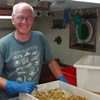General Description
Rostrum narrow, acute, flattened between orbitorostral grooves which are overhung by base of rostrum and by medial margin of orbital hoods; orbital hoods with crest but without teeth; rostrum-hood margins concave. Large claw (chela) laterally compressed; lower margin slightly concave; upper margin with transverse slit near base of last segment (dactylus); without lateral and mesial teeth near dactylar articulation; with few scattered setae. Small claw (chela) of balaeniceps form in male only, dactylus not broadened. Dark colour. Up to 7 cm wide.
Biology
Snapping shrimps or pistol shrimps are immediately distinguished from other families by having one claw much larger than the other, the larger claw cylindrical and with a parrot-beak-like finger. The snapping apparatus on the claw involves a piston at the base of the moveable finger that fits into a cavity of the fixed finger. When clicked closed by the strong muscles in the palm, a sudden jet of water is expelled to stun its prey, such as crabs and fishes. A sharp click is heard at the same time and may even be audible to us when walking over mudflats where the shrimps can be common.
Habitat
Intertidal under rocks, from cavities in bases of clumps of the tunicate Pyura stolonifera, depths to 26 m.
Reefs
Soft substrates
Coastal shores
Distribution guide
Lord Howe Island, New Zealand and southern Australia.
Species Group
Prawns, shrimps, lobsters › Shrimps
Depth
Shore (0-1 m)
Shallow (1-30 m)
Water Column
Max Size
7 cm
Diet
Organic matter
Commercial Species
No
Global Dispersal
Native to Australia
Species Code
MoV 997
Conservation Status
- DSE Advisory List : Not listed
- EPBC Act 1999 : Not listed
- IUCN Red List : Not listed







